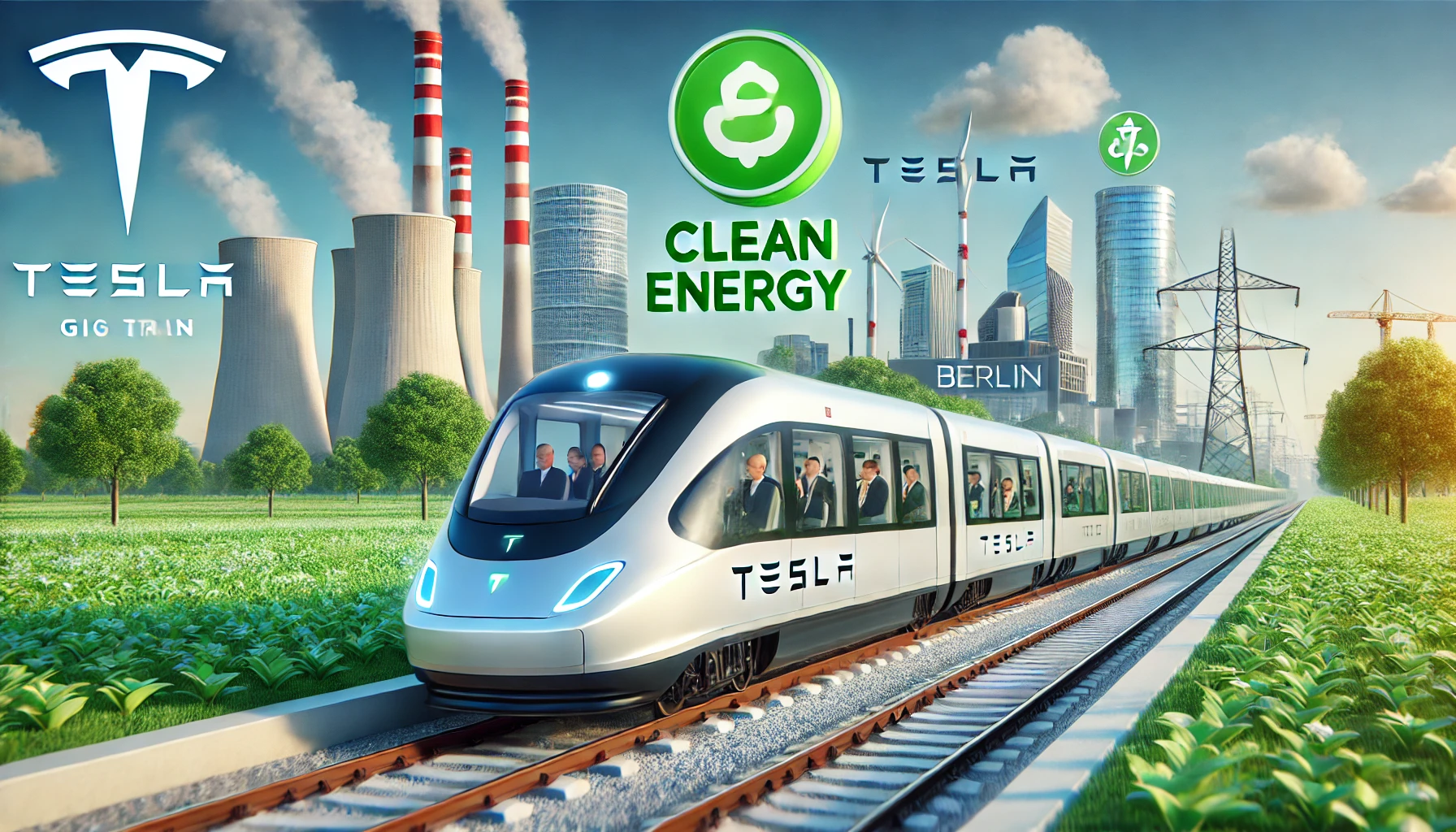The Tesla Giga Train: A Revolutionary Leap in Sustainable Transportation at Giga Berlin
Tesla Giga Train: Tesla has been at the forefront of the electric vehicle revolution, and now it’s making waves in public transportation with its Tesla Giga Train. Launched in Berlin, this innovative electric train is part of the company’s broader green initiatives to offer sustainable and efficient transport solutions, not just for Tesla employees but for the general public as well. With its impressive range of features, including being battery-powered and fully electric, the Giga Train is redefining how we think about transportation.
In this blog post, we’ll explore Tesla’s Giga Train and its impact on public transport, sustainable transportation, and how Tesla’s initiatives could transform urban commuting. We’ll also look at how Tesla’s employee shuttle service plays a crucial role in their green transportation strategy.
What is the Tesla Giga Train?
The Tesla Giga Train is Tesla’s first electric train service, launched in August 2024 in Berlin. Its primary role is to provide an eco-friendly shuttle between Erkner Station and Tesla’s Gigafactory Berlin. This Giga Berlin train is a battery-powered marvel designed not only to serve Tesla employees but also to reduce the overall carbon footprint of public transportation in the area.
Tesla’s mission has always been to accelerate the transition to renewable energy, and the Tesla Giga Train aligns perfectly with that mission. Each train can accommodate up to 500 passengers, with enough room for bicycles, making it a convenient and sustainable alternative to car commutes.
The Tesla Train in Berlin: Key Features
Some of the unique features of the Tesla Giga Train include:
- Battery-powered technology: The train runs entirely on battery power, eliminating the need for diesel engines and drastically cutting down on CO2 emissions.
- Green transportation: With the capacity to transport 4,500 employees daily, the train eases congestion on the roads, reduces commuting times, and offers an environmentally friendly alternative to driving.
- Public access: While initially designed for Tesla employees, the train is also available to the general public, further promoting electric public transportation.
The Tesla Giga Train’s success in Berlin has already sparked interest in replicating this model in other regions. Tesla has proven that electric public transportation can be both efficient and sustainable.
Tesla’s Commitment to Sustainable Transportation
Tesla’s green initiatives go beyond just electric vehicles. The Tesla Giga Train is a part of the company’s broader effort to offer sustainable transportation solutions that are both scalable and impactful.
Why Sustainable Transportation Matters
The transportation sector is one of the largest contributors to greenhouse gas emissions. By introducing battery-powered trains and electric vehicles, Tesla is directly addressing the issue of carbon emissions. According to a recent report by the International Energy Agency (IEA), the transportation sector accounts for nearly 24% of global CO2 emissions.
Through innovations like the Tesla Giga Train, the company is actively working to reduce this figure by providing electric public transportation solutions that are accessible, reliable, and eco-friendly.
Tesla’s Green Initiatives: A Broader Vision
Tesla’s commitment to green initiatives is not limited to trains. The company is continually working on advancing its electric vehicle technology, including electric trucks and buses, all aimed at creating a future where transportation is powered by renewable energy. The introduction of the Tesla Giga Train demonstrates how Tesla’s sustainable vision extends beyond personal vehicles into mass transit.
For more insights into sustainable transportation and how it can help reduce emissions globally, explore the educational resources available at Regent Studies.
How the Tesla Giga Train Benefits Employees and Local Communities
The Tesla Giga Train is not only a technological marvel but also a practical solution to workforce transportation. It efficiently transports thousands of Tesla employees to and from work daily, ensuring punctuality and reducing the stress of commuting. By offering the Tesla employee shuttle, Tesla improves the overall efficiency of its workforce, allowing the Gigafactory in Berlin to operate more smoothly.
The Tesla Employee Shuttle: A Closer Look
Tesla’s employee shuttle services are a significant part of the company’s efforts to improve both productivity and sustainability. The Tesla employee shuttle, which includes the Giga Train, allows the company to streamline commuting and reduce traffic congestion around the Gigafactory.
Key benefits of the Tesla employee shuttle include:
- Reduced traffic: By offering a train service capable of transporting 500 passengers at once, Tesla significantly reduces the number of cars on the road.
- Eco-friendly commuting: Employees no longer have to rely on personal vehicles, contributing to lower carbon emissions.
- Workforce efficiency: The Giga Train ensures that employees arrive on time, reducing delays and increasing operational efficiency at the Gigafactory.
In addition to benefiting employees, the train also provides a green transportation option for local residents. This inclusive approach reflects Tesla’s commitment to community engagement and environmental stewardship.
Battery-Powered Trains: The Future of Public Transport
The Tesla battery train is not just a step toward greener transportation; it’s a blueprint for the future. Battery-powered trains, like the Tesla Giga Train, offer several advantages over traditional diesel-powered trains, particularly in reducing operational costs and lowering greenhouse gas emissions.
Advantages of Battery-Powered Trains
- Reduced emissions: The Tesla battery train eliminates the need for fossil fuels, leading to a significant reduction in CO2 emissions. In the case of the Giga Train, Tesla estimates a weekly saving of 50 tons of CO2.
- Lower operational costs: Electric trains are generally cheaper to operate than their diesel counterparts. Without the need for fuel and with fewer moving parts to maintain, battery-powered trains can help reduce transportation costs for companies like Tesla.
- Scalability: The success of the Tesla Giga Train in Berlin has opened the door for similar projects in other regions, making battery-powered trains a scalable solution for public transportation.
Tesla’s green initiatives and investment in battery-powered trains signal a future where electric public transportation becomes the norm, replacing outdated, polluting alternatives.
Tesla’s Broader Impact on Green Public Transportation
Tesla’s foray into public transportation is just the beginning. By investing in electric public transportation options like the Giga Train, Tesla is setting a precedent for other companies to follow. This not only helps to address current transportation challenges but also lays the groundwork for a more sustainable future.
Expanding Beyond Berlin
Given the success of the Giga Berlin train, there are plans to expand this model to other cities and countries. Tesla’s continued innovation in the field of electric public transportation could revolutionize the way we commute, both on a local and global scale.
For a deeper dive into Tesla’s ongoing green transportation projects, check out this article on Tesla’s official website.
The Future of Sustainable Transportation is Here
The Tesla Giga Train is a groundbreaking step toward achieving a future of sustainable transportation. With its battery-powered technology, employee-focused shuttle services, and public access, it serves as a model for green innovation in mass transit. Tesla’s green initiatives and commitment to electric public transportation will undoubtedly continue to shape the future of urban mobility and public transportation.
As the world moves toward more sustainable solutions, Tesla’s Giga Train and broader efforts in green transportation set a powerful example of what’s possible when innovation meets environmental responsibility. Stay tuned to Tesla’s evolving transportation projects and visit Regent Studies for more educational content on how green technology is transforming the world.




